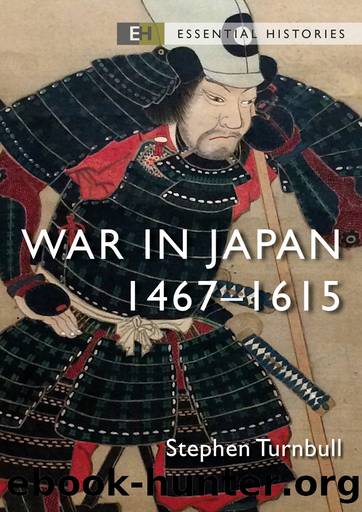War in Japan by Stephen Turnbull

Author:Stephen Turnbull [Turnbull, Stephen]
Language: eng
Format: epub
ISBN: 9781472851208
Published: 2022-06-15T00:00:00+00:00
In this detail from a modern copy in Nakatsu Castle of the famous painted screen of the battle of Nagashino, Oda Nobunaga is shown advancing to the attack.
Uesugi Kenshin receives his generals in a maku (curtained field headquarters) at Nanao. Kenshin wears a monkâs headdress.
Nobunagaâs final campaign was conducted against Iga Province in 1581 and was a particularly savage affair. Oda Nobukatsu, Nobunagaâs heir who had been adopted into the Kitabatake family of Ise, had made an attempt to conquer Iga in 1579 but was driven back by surprise attacks, during which one of his leading generals was killed. Furious at the reversal, Nobunaga sent five armies into Iga from different directions. The defenders were unable to use the guerrilla tactics that had triumphed against Nobukatsu and withdrew to fortresses that were speedily reduced with much slaughter. The local people hit back with raids that would lead to the legends of Iga being the home of the ninja, but in the end their resistance proved to be in vain.
In 1582 Torigoe in Kaga was to provide a suitably dramatic location for the last stand of the Kaga IkkÅ-ikki, who had fought on after Ishiyama Honganji had surrendered. The first attack upon the IkkÅ-ikkiâs fortified temples of Torigoe and Futoge was made by Nobunagaâs general Shibata Katsuie. He captured both places and set up a garrison of 300 men, but before the month was out the IkkÅ-ikki had recaptured them and slaughtered the unfortunate 300 troops. In the eleventh month of 1581, Shibata Katsuie and his fellow general Sakuma Morimasa returned to Kaga and crushed the resistance. We read that on the 17th day of that month the heads of the ringleaders were sent to Nobunagaâs castle of Azuchi and placed on public display. Yet in spite of this setback IkkÅ-ikki resistance continued, and elements of the organisation recaptured Torigoe and Futoge for a second time in 1582. The defences were rapidly strengthened to face an anticipated third attack by Oda Nobunagaâs forces, as was revealed when storage jars were found during archaeological investigations in the 20th century. This time no chance of resurgence was to be allowed and 300 men of the IkkÅ-ikki were crucified on the river bed.
Download
This site does not store any files on its server. We only index and link to content provided by other sites. Please contact the content providers to delete copyright contents if any and email us, we'll remove relevant links or contents immediately.
Kathy Andrews Collection by Kathy Andrews(10510)
The remains of the day by Kazuo Ishiguro(7544)
Spare by Prince Harry The Duke of Sussex(4188)
Paper Towns by Green John(4165)
The Body: A Guide for Occupants by Bill Bryson(3791)
Be in a Treehouse by Pete Nelson(3207)
Harry Potter and the Goblet Of Fire by J.K. Rowling(3026)
Goodbye Paradise(2951)
Never by Ken Follett(2873)
Into Thin Air by Jon Krakauer(2695)
The Remains of the Day by Kazuo Ishiguro(2614)
The Genius of Japanese Carpentry by Azby Brown(2602)
The Cellar by Natasha Preston(2592)
Drawing Shortcuts: Developing Quick Drawing Skills Using Today's Technology by Leggitt Jim(2529)
120 Days of Sodom by Marquis de Sade(2428)
Architecture 101 by Nicole Bridge(2348)
The Man Who Died Twice by Richard Osman(2291)
Machine Learning at Scale with H2O by Gregory Keys | David Whiting(2269)
Fairy Tale by Stephen King(2059)
